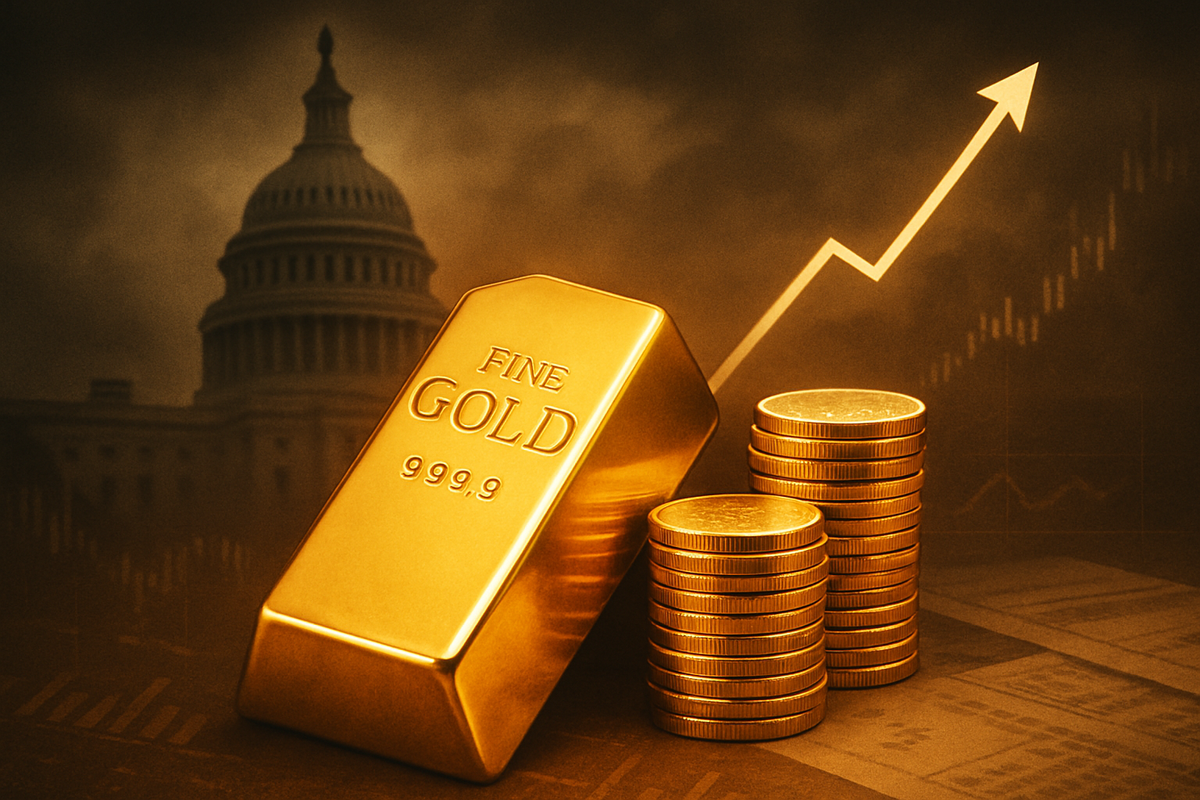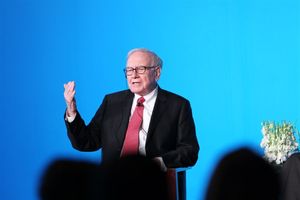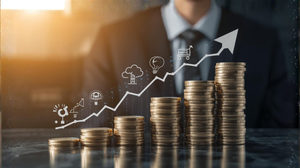
New York, NY – October 2, 2025 – Gold prices have shattered all previous records, surging to unprecedented levels as a US government shutdown takes hold and a confluence of broader economic uncertainties continues to rattle global markets. The precious metal, long considered a bastion of stability in times of turmoil, has seen its value skyrocket, with spot gold prices hitting approximately $3,858.45 per troy ounce and futures contracts nearing the $3,900 mark. This remarkable ascent underscores a pervasive sense of investor anxiety, as market participants flock to safe-haven assets amidst a landscape fraught with fiscal instability and an opaque economic outlook.
The immediate trigger for gold's latest leg up is the US government shutdown, which commenced on October 1, 2025. This fiscal impasse has not only cast a shadow over Washington but has also immediately led to the delay of critical economic data, including the eagerly anticipated September employment report. This data vacuum further exacerbates market uncertainty, complicating the Federal Reserve's policy decisions and leaving investors grasping for clarity. The dollar has simultaneously weakened, making gold more attractive to international buyers, while expectations of further interest rate cuts by the Federal Reserve, driven by weak inflation and rising unemployment, further fuel the bullish sentiment for the yellow metal.
Unpacking the Gold Rush: A Timeline of Turbulence
The current surge in gold prices to record highs is the culmination of a year-long rally, intensified by the latest political gridlock in the United States. Throughout 2025, gold futures have witnessed an astonishing increase of over 45%, reflecting a persistent and growing demand for safe-haven assets. The most recent catalyst, the US government shutdown, began just yesterday, October 1, 2025, after lawmakers failed to reach an agreement on appropriations, effectively halting non-essential government operations and furloughing hundreds of thousands of federal employees.
This shutdown immediately plunged financial markets into greater uncertainty. Critical economic indicators, vital for assessing the health of the US economy and guiding monetary policy, have been postponed, creating a significant informational void. Investors, already wary of persistent trade wars and tariffs imposed by President Donald Trump's administration since the start of 2025—which have led to higher costs, a weakened job market, and increased consumer pessimism—have reacted by aggressively reallocating capital into gold. The weakening US dollar, hovering near a one-week low, further amplifies gold's appeal, making it more affordable for holders of other currencies.
Key players in this unfolding drama include the US government and its legislative bodies, whose inability to pass a budget has directly led to the shutdown. The Federal Reserve also plays a crucial role, with market expectations now firmly set on continued interest rate cuts to combat weak inflation and rising unemployment, a policy stance that historically benefits non-yielding assets like gold. Beyond domestic factors, global central banks have been consistently increasing their gold reserves throughout 2025, strategically diversifying away from traditional currencies, thereby providing a sustained floor of demand for the precious metal. Initial market reactions have been characterized by heightened volatility, a noticeable shift towards risk-off assets, and warnings from bodies like the Commodity Futures Trade Commission (CFTC) about the inherent volatility of precious metals markets during such periods.
Winners and Losers in the Golden Glow
The unprecedented surge in gold prices creates a distinct bifurcation in the financial markets, producing clear winners and potential losers. Gold mining companies, in particular, are poised to benefit significantly from the elevated prices, as their primary commodity now commands a substantially higher value. Companies such as Barrick Gold (NYSE: GOLD) and Newmont Corporation (NYSE: NEM), two of the world's largest gold producers, stand to see substantial increases in their revenues and profitability. Higher gold prices directly translate to fatter profit margins, potentially leading to increased dividends, share buybacks, and investment in exploration and production, further boosting their stock valuations. Junior mining companies, with higher operational leverage to commodity prices, could experience even more dramatic gains, albeit with higher risk.
Conversely, sectors highly sensitive to economic stability and consumer confidence are likely to face headwinds. Financial institutions, particularly those with significant exposure to lending or capital markets that thrive on predictable economic conditions, could see reduced activity and increased loan defaults if the shutdown prolongs and economic uncertainty deepens. Consumer discretionary companies, which rely on consumer spending for growth, may experience a downturn as households become more cautious with their finances. Furthermore, industries heavily dependent on government contracts or regulatory approvals could suffer delays and financial strain due to the shutdown. Companies with substantial dollar-denominated debt might also find their debt servicing costs effectively reduced by a weaker dollar, but this benefit could be overshadowed by broader economic malaise. While a weaker dollar generally helps US exporters, the overall climate of uncertainty and delayed economic data could dampen global trade, offsetting potential currency advantages for many businesses.
Wider Significance: A Crisis of Confidence and a Shift in Global Dynamics
The current US government shutdown and the subsequent surge in gold prices are not isolated incidents but rather symptomatic of deeper, interconnected shifts in global economic and political landscapes. The shutdown, which began on October 1, 2025, underscores a persistent political dysfunction that erodes confidence in the US government's ability to manage its fiscal affairs. Historically, such shutdowns have caused a modest drag on GDP—Goldman Sachs estimates a reduction of approximately 0.2 percentage points for each week of extension—and have disrupted various sectors, from defense contractors facing payment delays to biotech companies awaiting regulatory approvals. This ongoing instability contributes to a broader trend of economic uncertainty, prompting a flight to safety.
The record-breaking gold prices, which have climbed over 45% in 2025, fit squarely into several significant industry trends. Firstly, it reaffirms gold's enduring role as the ultimate safe-haven asset, a refuge during periods of heightened economic and geopolitical risk. Secondly, it reflects growing concerns over inflation and currency debasement, particularly as the Federal Reserve maintains an accommodative monetary policy with expectations of further rate cuts, reducing the opportunity cost of holding non-yielding gold. Thirdly, the aggressive gold purchasing by global central banks throughout 2025 signals a strategic move towards de-dollarization and diversification of reserves, indicating a subtle but significant shift in global financial power dynamics.
The ripple effects are far-reaching. For competitors, a prolonged US shutdown could inadvertently benefit other developed economies and financial centers in Asia and Europe, as international investors seek more stable environments. Federal contractors, partners of the US government, face immediate operational disruptions and financial strain, potentially forcing them to scale back activities or seek alternative funding. Global supply chains, already fragile, could experience further logistical and operational challenges due to regulatory backlogs. Within the precious metals sector, while gold miners revel in the high prices, industries like jewelry and high-tech manufacturing, which use gold as an input, face increased costs, potentially squeezing their margins or necessitating price increases for consumers.
Regulatory and policy implications are profound. The shutdown creates regulatory bottlenecks, delaying everything from environmental permits to financial oversight, and further complicates the Federal Reserve's monetary policy decisions by withholding crucial economic data. This erosion of trust in governance could have long-term consequences for investor confidence. On the monetary front, the Federal Reserve's dovish stance directly influences gold's appeal, while the metal's ascent, coupled with a weakening dollar, could spark broader policy discussions about the US dollar's future as the global reserve currency. Historically, while past shutdowns like the 2013 or 2018-2019 events had temporary economic impacts, their direct correlation with gold prices was often muted. However, the current confluence of a shutdown, a weakening dollar, and explicit expectations of Fed rate cuts makes this event a more potent driver for gold, aligning with a broader global trend of seeking stability amidst pervasive uncertainty.
What Comes Next: Navigating a Volatile Path
The current landscape, defined by a US government shutdown and gold's unprecedented rally, sets the stage for a period of heightened market volatility and strategic re-evaluation. In the short term, the US economy faces immediate headwinds. Each week of the shutdown is estimated to shave 0.1-0.2 percentage points off GDP growth, primarily due to furloughed federal employees and delayed government services. The critical data blackout, including the postponed September employment report, will leave the Federal Reserve and investors flying blind, complicating monetary policy decisions and fostering an environment of speculation. Should the shutdown be prolonged, especially with President Trump's reported threat of permanent layoffs for furloughed workers, the economic drag could become more severe and lasting, potentially pushing the Federal Reserve to implement more aggressive interest rate cuts to avert a deeper slowdown.
For gold, the short-term outlook remains bullish. Already trading at record highs above $3,890-$3,900 per ounce, some analysts anticipate a breach of the $4,000 mark. Its role as a safe haven, coupled with a weakening dollar and the strong expectation of Fed rate cuts, provides robust tailwinds. However, gold's rapid ascent has pushed it into "extremely overbought conditions," suggesting that while pullbacks are likely to be met with buying interest, some short-term consolidation or correction cannot be ruled out if the immediate uncertainty surrounding the shutdown subsides.
In the long term, the US economy faces a period of slower growth, with the IMF projecting 1.8% for 2025 and 1.7% for 2026, influenced by escalating trade wars and policy uncertainty. Persistent inflation, potentially reaching 3% by year-end, remains a concern, even as the Federal Reserve is expected to continue its easing cycle with further rate cuts into 2026. This accommodative monetary policy, alongside ongoing geopolitical tensions and central bank diversification away from the dollar, will likely continue to underpin gold's appeal. UBS and Macquarie have set long-term price targets for gold at $3,900/oz by June 2026 and $4,000/oz for 2026, respectively, reflecting a sustained bullish outlook.
Investors should consider several strategic pivots. Diversification across asset classes, with increased exposure to safe-haven assets like gold (and potentially silver or even Bitcoin (CRYPTO: BTC) as a complementary hedge), is paramount. Focusing on defensive stocks in sectors less reliant on government activity, such as consumer staples, healthcare, or technology (especially cloud services), and companies with significant international revenue streams, can offer resilience. Avoiding panic selling during market corrections, which are often temporary, and viewing gold price dips as buying opportunities are also key. Ultimately, closely monitoring the resolution of the government shutdown and the Federal Reserve's evolving monetary policy will be crucial in navigating the market's trajectory.
Comprehensive Wrap-Up: Gold's Enduring Appeal in an Age of Uncertainty
The current financial landscape, marked by gold prices reaching unprecedented highs amidst a US government shutdown and pervasive economic uncertainties, serves as a stark reminder of the precious metal's enduring role as a safe-haven asset. As of October 2, 2025, the confluence of political gridlock, delayed economic data, a weakening US dollar, and expectations of further Federal Reserve interest rate cuts has created a perfect storm for gold's spectacular rally, pushing it to nearly $3,900 per troy ounce. This event is not merely a transient market reaction but reflects deeper structural shifts, including persistent inflation concerns, escalating trade tensions, and a global trend of central banks diversifying their reserves away from traditional currencies.
Moving forward, the market will remain highly sensitive to developments in Washington regarding the government shutdown. A swift resolution might bring some short-term relief to equity markets and potentially lead to profit-taking in gold, but the underlying economic uncertainties and dovish monetary policy are expected to maintain a strong floor under gold prices. Conversely, a prolonged shutdown, particularly one involving permanent job cuts, could inflict more significant damage on the US economy, further weakening the dollar and intensifying gold's safe-haven appeal for an extended period.
For investors, the key takeaway is the imperative for strategic resilience. Diversification, with a deliberate allocation to gold and other defensive assets, is crucial. While gold's current "overbought" status suggests caution, its fundamental drivers—including central bank demand, geopolitical risks, and the Federal Reserve's accommodative stance—point to sustained strength in the long term. Investors should closely watch for any signs of a resolution to the government shutdown, the Federal Reserve's next moves on interest rates, and the trajectory of inflation and trade policies. In an era where political stability and economic predictability are increasingly elusive, gold's glitter shines brighter than ever, solidifying its position as a cornerstone of wealth preservation and a hedge against the unknown.
This content is intended for informational purposes only and is not financial advice





